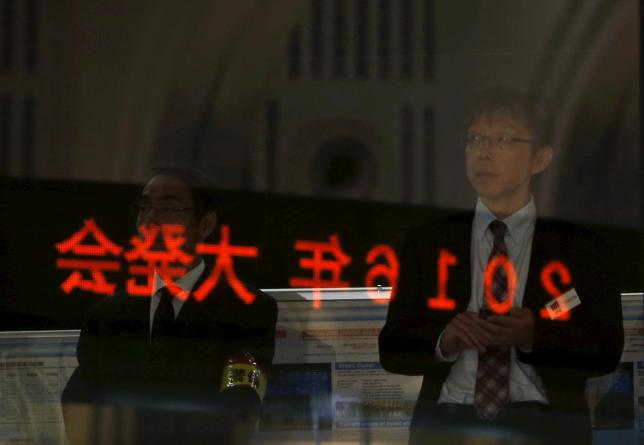
A visitor waits for the New Year opening ceremony at the Tokyo Stock Exchange (TSE), held to wish for the success of Japan’s stock market, in Tokyo, Japan, January 4, 2016. REUTERS/Yuya Shino
Global shares dropped for a sixth day on Thursday and oil prices fell to levels not witnessed since the early 2000s, after China guided the Yuan lower and Shanghai shares tumbled by 7 percent, igniting fears of competitive devaluations across Asia.
Chinese stock trading was suspended for a second time this week, less than half an hour after the market opened.
Brent crude prices fell over 5 percent to an almost-12-year-low of $32.16, with fears over less demand from China adding to a continual drag on prices caused by oversupply and near-record output levels.
European stock markets followed Asia lower, with the pan-European FTS Euro first 300 index down 2.3 percent and the euro zone’s blue-chip Euro STOXX index falling 2.5 percent.
MCCI’s 46-country All World index fell 1 percent to hit a three-month low, the sixth straight day of losses. The benchmark emerging stock index fell 2.5 percent to a 6 1/2-year low as investors dumped risky assets.
“It’s looking pretty ugly,” said hedge fund manager and chief investment officer Andreas Clenow at ACIES Asset Management in Zurich. “We’ve been scaling down equity positions. It’s time to take a step back to re-evaluate the situation.”
The People’s Bank of China (PBOC) set the Yuan midpoint rate at 6.5646 per dollar, 0.5 percent weaker than the previous day’s fix. That was the biggest decline between daily fixings since August and the eighth day in row the PBOC had set a lower guidance rate.
Spot Yuan fell to 6.5956 to the dollar, its weakest since February 2011. Offshore Yuan rates hit a record low of 6.7600 to the dollar, before erasing its losses after suspected intervention by authorities.
Other regional currencies followed the Yuan down as markets began to worry about competitive currency devaluations from trading partners. Singapore’s dollar hit a six-year low, the South Korean won touched a four-month low, and the Malaysian ringgit slumped to a three-month trough.
Investors fear China’s economy is even weaker than had been imagined, with Beijing, in a bid to help exporters, allowing the Yuan’s depreciation to accelerate.
“The lower Yuan fixing probably signifies greater risks to the Chinese economy than we know of, leading to risk-off trades,” said Jeremy Stretch, head of currency strategy at CIBC World Markets.
